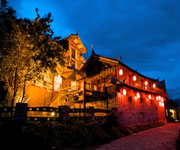The Old Town of Lijiang, which is perfectly adapted to the uneven topography of this key commercial and strategic site, has retained a historic townscape of high quality and authenticity. Its architecture is noteworthy for the blending of elements from several cultures that have come together over many centuries. Lijiang also possesses an ancient water-supply system of great complexity and ingenuity that still functions effectively today. Lijiang is an exceptional ancient town set in a dramatic landscape which represents the harmonious fusion of different cultural traditions to produce an urban landscape of outstanding quality.

Continent: Asia
Country: China
Category: Cultural
Criterion: (II)(IV) (V)
Date of Inscription: 1997
Historic Background of Old Town of Lijiang
In the 13th century AD, during the later Southern Song dynasty, the ancestors of the ruling Mu family moved their main centre from Baisha to the foot of the Shizi Mountains to a new town known as Dayechang (later Dayan), where they began building houses surrounded by a city wall and moat. After Azong Aliang submitted in the 1250s to the authority of the Yuan Emperor Hubilie, Dayechang became an administrative centre. The Lijiang Junmin prefecture was established when the region came under Ming rule in 1382.In 1724 the first non-native prefect began building prefectural offices, barracks and educational facilities at the foot of the Jinhong Mountain. Lijiang County was created as part of Lijiang Junmin Prefecture in 1770. The old town of Lijiang is built on a mountain slope running from north-west to south-east, facing a deep river.
 |
| Old Town of Lijiang China |









Hi! I’m Thien from Vietnam. Thanks greatly for your sharing! That’s really helpful! If you are planning to visit Hanoi - the capital of Vietnam rich in culture and history but haven't decided when to come yet, refer to this Best month to visit Hanoi to get all the information needed.
ReplyDeleteHope to see you in Vietnam!